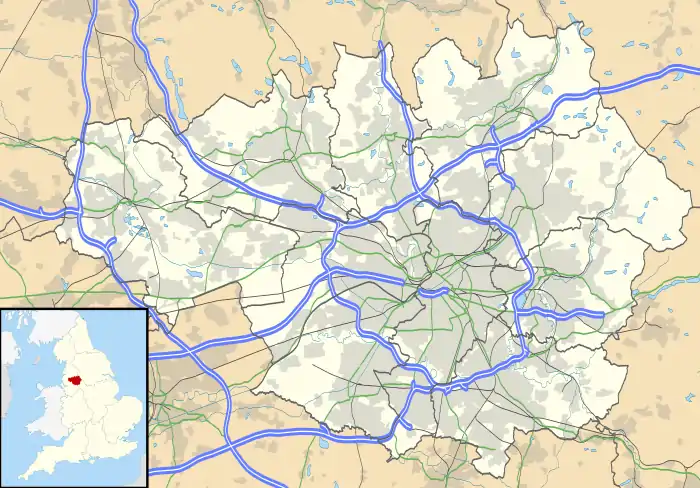Thorp Mill, Royton
Thorp Mill, Royton was built by Ralph Taylor at Thorp Clough in 1764.[2] [3][4] This is reputed to be the first cotton mill in Lancashire to be powered by water. Ralph Taylor bought three existing cottages which he converted into a mill. This was a carding mill, and was powered by a water wheel driven from Thorp Clough, a tributary of the River Irk. The mill closed in 1788 when the mill and contents were advertised for sale by the then owner James Taylor. It was advertised again in 1792, and the buildings reverted to cottages, and were subsequently demolished. The mill is marked by a blue plaque.
 Landscape around Royton, showing the River Irk | |
 Location in Greater Manchester | |
| Cotton | |
|---|---|
| Carding | |
| Location | Thorp, Royton, Lancashire, England |
| Owner | Ralph Taylor |
| Further ownership |
|
| Coordinates | 53.5660°N 2.1358°W |
| Construction | |
| Completed | 1764 (Conversion from cottages) |
| Demolished | Reverted to cottages before 1800 |
| Carding Equipment | Yes |
| References | |
| [1] | |
Thorp itself is higher up the clough and is the oldest hamlet in Royton, Lancashire.
The construction of more mills followed, which initiated a process of urbanisation and socioeconomic transformation in the region; the population moved away from farming, adopting employment in the factory system.[5] The introduction of which led to a tenfold increase of Royton's population in less than a century; from 260 in 1714 to 2,719 in 1810.[5] The introduction of textile manufacture during the Industrial Revolution facilitated a process of unplanned urbanisation in the area, and by the mid-19th century Royton had emerged as a mill town.
References
- Notes
- Stott 1994
- Oldham Council, Oldham's Economic Profile - Innovation and Technology, oldham.gov.uk, archived from the original on 2007-01-13, retrieved 2008-07-20
- Manchester City Council, Oldham Towns; Royton, spinningtheweb.org.uk, retrieved 2007-01-05
- Stott 1994, p. 10.
- Stott 1994, p. 6.
- Bibliography
- Dunkerley, Philip (2009). "Dunkerley-Tuson Family Website, The Regent Cotton Mill, Failsworth". Archived from the original on 2008-03-23. Retrieved 2009-01-09.
- LCC (1951). The mills and organisation of the Lancashire Cotton Corporation Limited. Blackfriars House, Manchester: Lancashire Cotton Corporation Limited.
- Roberts, A S (1921), "Arthur Robert's Engine List", Arthur Roberts Black Book., One guy from Barlick-Book Transcription, archived from the original on 2011-07-23, retrieved 2009-01-11
- Brownbill, John; Farrer, William (1911), A History of the County of Lancaster: Volume 5, Victoria County History, ISBN 978-0-7129-1055-2
- Frangopulo, N. J. (1977), Tradition in Action: The Historical Evolution of the Greater Manchester County, Wakefield: EP, ISBN 0-7158-1203-3CS1 maint: ref=harv (link)
- Gurr, Duncan; Hunt, Julian (1985). The Cotton Mills of Oldham. Oldham Education & Leisure. ISBN 0-902809-46-6.CS1 maint: ref=harv (link)
- McNeil, R & Nevell, M (2000), A Guide to the Industrial Archaeology of Greater Manchester, Association for Industrial Archaeology, ISBN 0-9528930-3-7
- Stott, Frances (1994), Looking Back at Royton, Oldham: Oldham Arts and Heritage, ISBN 0-902809-29-6CS1 maint: ref=harv (link)

